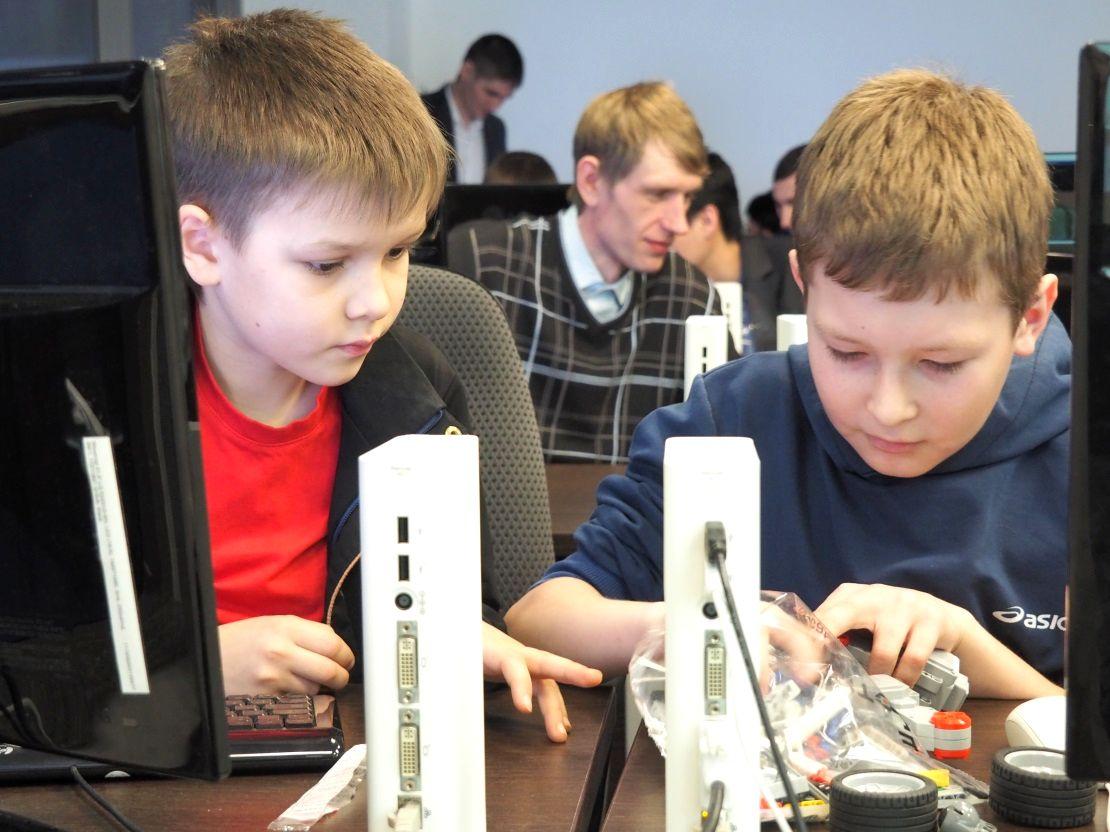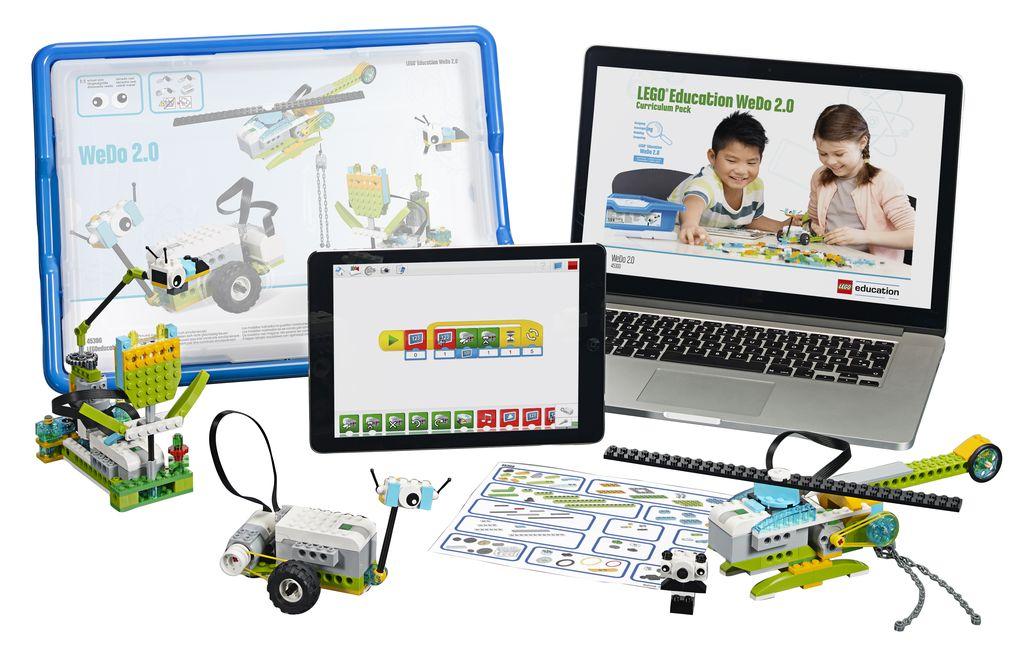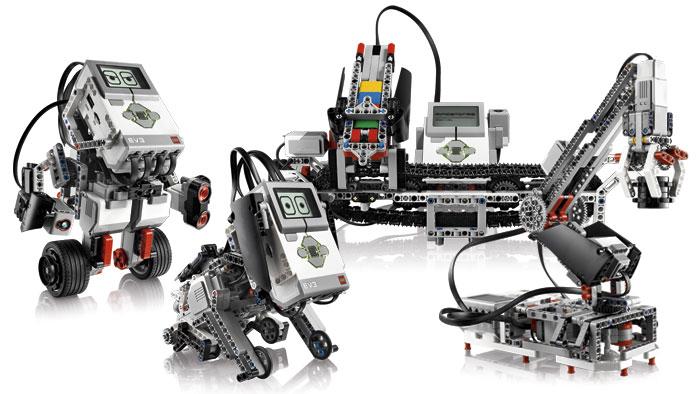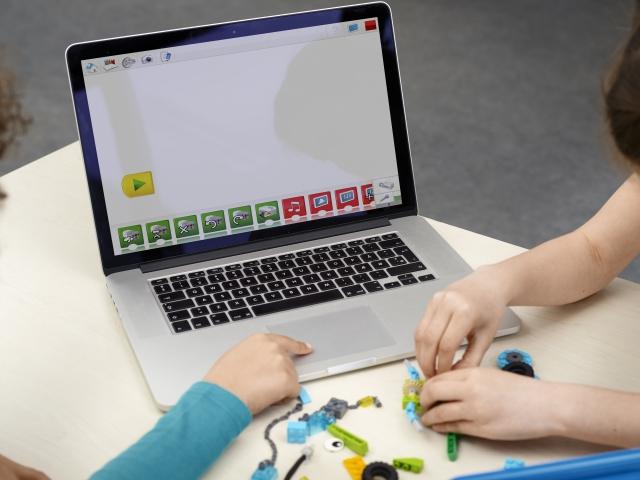LEGO Education WeDo 2.0 and EV3: Frequently Asked Questions
In the corporate blog LEGO Education on Geektimes.ru and Habrahabr.ru, we are often asked questions about our educational solutions LEGO Education WeDo 2.0 and LEGO MINDSTORMS Education EV3. Many of them are repeated from post to post, in connection with which we decided to create a FAQ for our subscribers and make some explanations and additions, which, as it seemed to us, our readers are waiting. In part, we will try to dispel some myths by answering technical and some other questions. So, a brief information in the format of "question-answer".

The statement looks strange, because we all know that the key part of any LEGO Education solution is LEGO brick. LEGO Education is a designer that can be assembled in different ways each time. An interesting fact: even three LEGO cubes with a size of 2 x 4 can be connected in 1060 different ways. 6 identical LEGO cubes (!) Will give you more than 915 million different variations. Imagine how many ways of assembly exist in the basic set of WeDo 2.0, which contains 280 parts and elements of LEGO. In fact, each set of LEGO Education contains an infinite number of models: robots, mechanisms, buildings. And the number of decisions or tasks is limited only by the imagination and knowledge of the student, as well as professionalism and openness of the teacher.

')
Of course, LEGO parts do not always allow to assemble what the inventor intended due to certain design constraints. And it is true. The model of LEGO parts will never be 100% original tower crane or mechanism for controlling the integrity of the gas transmission system. But if you think about it, any process engineer in the real world always faces such a situation. There are always certain limitations that he has to take into account when developing a particular mechanism or device (in fact, we are talking about modeling). For example, automotive engineers often use standardized parts and structural elements from older models, developing new ones. This is due to budget constraints and development time. Maybe they want to do something differently, but you have to use a certain power element of the body or part of the transmission. LEGO Education models such situations within the framework of a conventional computer science or technology lesson, allowing the student to develop the skills of engineering and design activities within limited resources, which, however, are guaranteed enough to solve the problem. And if not, you can use a 3D printer and create something that is missing. This is a great way to combine engineering with applied engineering.

Note that a large number of LEGO MINDSTORMS Education EV3 or WeDo 2.0 projects are open, i.e. do not imply any instructions for building or programming solutions. Students are encouraged to find a solution on their own. So, the assembly of certain initial models according to the instructions is only the first stage, the tip of the iceberg, which allows you to quickly and efficiently get acquainted with the key features of our educational solutions. But this does not mean that the whole LEGO training system rests on them.
Indeed, a number of educational solutions of LEGO Education until December 2016 required a separate purchase of teaching materials and / or software. This, however, did not apply to EV3 and WeDo 2.0. Software and absolutely all WeDo 2.0 training materials were and remain completely free. And the Base software (including the basic teaching materials) LEGO MINDSTORMS Education EV3 became free from January 1, 2016.

And since January 10, 2017, absolutely all LEGO Education teaching materials and LEGO Education software have become absolutely free for all users. Now all methodological and program materials are available for download from the LEGOeducation.ru website .
It is no secret that any quality product is expensive. For the level, which in fact lies not only in the materials used, but also in the production system, in the organization of quality control and in many other factors, you have to pay. And the LEGO sets and, of course, LEGO Education are very high quality products. You can learn more about how we make bricks here . But at the same time, while maintaining all the properties of the final product at the highest level, LEGO Education solutions are also among the most attractive in the market in terms of price / quality / opportunity ratio. Indeed, when comparing solutions, one should take into account not only the price, but also the significant advantages of applying a specific solution in education. Is there any other robotic platform besides EV3, for example, with the help of which you can not only tell children about robotics, but also effectively develop programming skills in them, assist in carrying out fascinating laboratory work in physics and chemistry, tell about space exploration, provide opportunity to participate in the world's largest robotic events? EV3 is both a universal (from the point of view of the study of subject areas) robotic platform, and a mobile digital science laboratory, and a handy tool for teachers to create their own learning content. And the LEGO details underlying it allow you to create an infinite number of models even from one LME EV3 set.

You can always get detailed information about the cost of our solutions from any official distributor of LEGO Education . This is the most correct and reliable source of information about the cost of our solutions. After all, we cannot guarantee the quality of information in search engines, but we confirm the information received from our distributors.
This is not true. Both platforms are fully open. You can create your own firmware, sensors, software using the official SDK from LEGO Education. In this development, for example, sensors for LME EV3 does not require licensing. And the companies developing third-party solutions for our platform, a huge amount. Including in Russia. All official SDKs also include detailed circuitry for the EV3 microcomputer and are available for download from the LEGO Education website .

WeDo 2.0 is much younger than EV3. Therefore, she has only one official SDK. But their number will increase. In the meantime, users have the opportunity to create their own software to work with WeDo 2.0 SmartHub , which was used by colleagues from MIT, having developed the Scratch version and for WeDo 2.0.
Of course, the SDK from LEGO Education can be used in educational activities, for example, for powerful laboratory work on the creation of new hardware or software additions to the existing software and hardware complex.
In 2006, MINDSTORMS NXT appeared with new RJ12 connectors. The choice of RJ12 was due to the used attachments and the openness of the platform: until now everyone can create their own sensors and motors for the MINDSTORMS EV3 using proprietary SDKs.

WeDo appeared later than the NXT, but it was impossible to use the same connectors for it because of its compactness (you can simply not connect 6 motors / sensors with an RJ12 connector to the WeDo microcomputer). Therefore, WeDo used original connectors. But in the EV3 RJ12 connectors remained for backward compatibility with NXT attachments.
In 2016, a new connector appeared on the WeDo 2.0 platform, which will soon become the same for all series, including WeDo, MINDSTORMS, Technics.
The LEGO Education sets are designed for both boys and girls, because both of them study in a regular secondary school. That is why such statistics are not kept. In fact, the distribution of girls and boys in terms of the use of LEGO Education coincides with the gender distribution within the age range of 7–17 years according to the Federal State Statistics Service of the Russian Federation. Designing, assembling models, programming is interesting for almost all children, regardless of gender. Of course, the profession of a programmer is more preferred by men, but even here it does not go without exceptions - and the further, the more. By the way, at the annual World Robotics Olympiad, which was held in 2016 in Indian New Delhi, the ratio of girls to boys was about 1: 5, respectively. And among the Russian champions WRO girls almost half.

The set 45544 was created for conducting educational activities and assumes the presence of a teacher who studies computer science, mathematics or physics with children, and the set 31313 is for an individual game. The main difference between the educational version of EV3 (45544) and the retail version (31313) is in software. Using the free software to 31313, the teacher will not be able to install additional sets of tasks, conduct laboratory work and experiments in chemistry and physics, edit existing or create their own educational content, monitor student performance through the built-in electronic notebooks and much more. At the same time, the educational software EV3 assumes work with the Basic set 45544 LEGO MINDSTORM Education EV3, since All instructions and lessons are designed precisely for the number of parts and sensors, which is included in set 45544.

In conclusion, we want to remind you that since November 14, 2016, LEGO Education launched a separate service channel for our end users. Now it will be much easier to contact directly the specialists of the company. To do this, we recommend to look at the tech support page on the LEGO Education website .
If you have any problems or questions, write to LERussia@LEGO.com or ask your questions through the official LEGO Education groups in social networks.
We will be in touch!

LEGO Education is instruction work that kills imagination and creativity.
The statement looks strange, because we all know that the key part of any LEGO Education solution is LEGO brick. LEGO Education is a designer that can be assembled in different ways each time. An interesting fact: even three LEGO cubes with a size of 2 x 4 can be connected in 1060 different ways. 6 identical LEGO cubes (!) Will give you more than 915 million different variations. Imagine how many ways of assembly exist in the basic set of WeDo 2.0, which contains 280 parts and elements of LEGO. In fact, each set of LEGO Education contains an infinite number of models: robots, mechanisms, buildings. And the number of decisions or tasks is limited only by the imagination and knowledge of the student, as well as professionalism and openness of the teacher.

')
Of course, LEGO parts do not always allow to assemble what the inventor intended due to certain design constraints. And it is true. The model of LEGO parts will never be 100% original tower crane or mechanism for controlling the integrity of the gas transmission system. But if you think about it, any process engineer in the real world always faces such a situation. There are always certain limitations that he has to take into account when developing a particular mechanism or device (in fact, we are talking about modeling). For example, automotive engineers often use standardized parts and structural elements from older models, developing new ones. This is due to budget constraints and development time. Maybe they want to do something differently, but you have to use a certain power element of the body or part of the transmission. LEGO Education models such situations within the framework of a conventional computer science or technology lesson, allowing the student to develop the skills of engineering and design activities within limited resources, which, however, are guaranteed enough to solve the problem. And if not, you can use a 3D printer and create something that is missing. This is a great way to combine engineering with applied engineering.

Note that a large number of LEGO MINDSTORMS Education EV3 or WeDo 2.0 projects are open, i.e. do not imply any instructions for building or programming solutions. Students are encouraged to find a solution on their own. So, the assembly of certain initial models according to the instructions is only the first stage, the tip of the iceberg, which allows you to quickly and efficiently get acquainted with the key features of our educational solutions. But this does not mean that the whole LEGO training system rests on them.
Software and training materials for many LEGO Education kits cost extra money, and a lot of money.
Indeed, a number of educational solutions of LEGO Education until December 2016 required a separate purchase of teaching materials and / or software. This, however, did not apply to EV3 and WeDo 2.0. Software and absolutely all WeDo 2.0 training materials were and remain completely free. And the Base software (including the basic teaching materials) LEGO MINDSTORMS Education EV3 became free from January 1, 2016.

And since January 10, 2017, absolutely all LEGO Education teaching materials and LEGO Education software have become absolutely free for all users. Now all methodological and program materials are available for download from the LEGOeducation.ru website .
LEGO Education is fashionable, but very expensive.
It is no secret that any quality product is expensive. For the level, which in fact lies not only in the materials used, but also in the production system, in the organization of quality control and in many other factors, you have to pay. And the LEGO sets and, of course, LEGO Education are very high quality products. You can learn more about how we make bricks here . But at the same time, while maintaining all the properties of the final product at the highest level, LEGO Education solutions are also among the most attractive in the market in terms of price / quality / opportunity ratio. Indeed, when comparing solutions, one should take into account not only the price, but also the significant advantages of applying a specific solution in education. Is there any other robotic platform besides EV3, for example, with the help of which you can not only tell children about robotics, but also effectively develop programming skills in them, assist in carrying out fascinating laboratory work in physics and chemistry, tell about space exploration, provide opportunity to participate in the world's largest robotic events? EV3 is both a universal (from the point of view of the study of subject areas) robotic platform, and a mobile digital science laboratory, and a handy tool for teachers to create their own learning content. And the LEGO details underlying it allow you to create an infinite number of models even from one LME EV3 set.

How much do LEGO Education educational solutions cost?
You can always get detailed information about the cost of our solutions from any official distributor of LEGO Education . This is the most correct and reliable source of information about the cost of our solutions. After all, we cannot guarantee the quality of information in search engines, but we confirm the information received from our distributors.
LEGO MINDSTORMS Education EV3 and WeDo 2.0 are closed platforms that do not allow to modify them for their needs.
This is not true. Both platforms are fully open. You can create your own firmware, sensors, software using the official SDK from LEGO Education. In this development, for example, sensors for LME EV3 does not require licensing. And the companies developing third-party solutions for our platform, a huge amount. Including in Russia. All official SDKs also include detailed circuitry for the EV3 microcomputer and are available for download from the LEGO Education website .

WeDo 2.0 is much younger than EV3. Therefore, she has only one official SDK. But their number will increase. In the meantime, users have the opportunity to create their own software to work with WeDo 2.0 SmartHub , which was used by colleagues from MIT, having developed the Scratch version and for WeDo 2.0.
Of course, the SDK from LEGO Education can be used in educational activities, for example, for powerful laboratory work on the creation of new hardware or software additions to the existing software and hardware complex.
Why on three different series - WeDo, MINDSTORM and Technic - incompatible connectors?
In 2006, MINDSTORMS NXT appeared with new RJ12 connectors. The choice of RJ12 was due to the used attachments and the openness of the platform: until now everyone can create their own sensors and motors for the MINDSTORMS EV3 using proprietary SDKs.

WeDo appeared later than the NXT, but it was impossible to use the same connectors for it because of its compactness (you can simply not connect 6 motors / sensors with an RJ12 connector to the WeDo microcomputer). Therefore, WeDo used original connectors. But in the EV3 RJ12 connectors remained for backward compatibility with NXT attachments.
In 2016, a new connector appeared on the WeDo 2.0 platform, which will soon become the same for all series, including WeDo, MINDSTORMS, Technics.
Are LEGO Education Kits for Boys Only? Are there statistics, how many boys and how many girls use LEGO?
The LEGO Education sets are designed for both boys and girls, because both of them study in a regular secondary school. That is why such statistics are not kept. In fact, the distribution of girls and boys in terms of the use of LEGO Education coincides with the gender distribution within the age range of 7–17 years according to the Federal State Statistics Service of the Russian Federation. Designing, assembling models, programming is interesting for almost all children, regardless of gender. Of course, the profession of a programmer is more preferred by men, but even here it does not go without exceptions - and the further, the more. By the way, at the annual World Robotics Olympiad, which was held in 2016 in Indian New Delhi, the ratio of girls to boys was about 1: 5, respectively. And among the Russian champions WRO girls almost half.

What is the difference between the 45544 LEGO MINDSTORMS Education EV3 educational version and the 31313 LEGO MINDSTORMS Education EV3?
The set 45544 was created for conducting educational activities and assumes the presence of a teacher who studies computer science, mathematics or physics with children, and the set 31313 is for an individual game. The main difference between the educational version of EV3 (45544) and the retail version (31313) is in software. Using the free software to 31313, the teacher will not be able to install additional sets of tasks, conduct laboratory work and experiments in chemistry and physics, edit existing or create their own educational content, monitor student performance through the built-in electronic notebooks and much more. At the same time, the educational software EV3 assumes work with the Basic set 45544 LEGO MINDSTORM Education EV3, since All instructions and lessons are designed precisely for the number of parts and sensors, which is included in set 45544.

In conclusion, we want to remind you that since November 14, 2016, LEGO Education launched a separate service channel for our end users. Now it will be much easier to contact directly the specialists of the company. To do this, we recommend to look at the tech support page on the LEGO Education website .
If you have any problems or questions, write to LERussia@LEGO.com or ask your questions through the official LEGO Education groups in social networks.
We will be in touch!
Source: https://habr.com/ru/post/400883/
All Articles